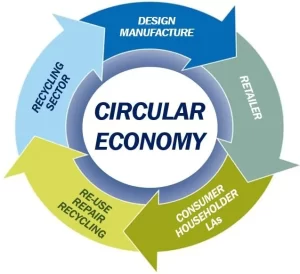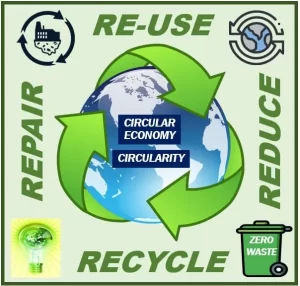A circular economy is one whose final objectives is to dispose of waste and the persistent intake of Earth’s sources. We frequently use the time period Circularity with the equal meaning. We can use circularity for the economy or person organizations, as in: “XXX Corporation has performed circularity throughout its whole operations.”
Circular economies create a closed-loop gadget with the aid of using using sharing, repair, re-use, remanufacturing, refurbishment, and recycling. They convey down their useful resource inputs and waste introduction to a minimum, in addition to carbon emissions and pollutants.

Circular economy – use things for longer
The goal of a circular economy is to apply infrastructure objects and gadget for considerably longer than usual, i.e., enhancing those sources’ productiveness. Any kind of waste need to now no longer be thrown out. Rather it need to turn out to be some other process’ food.
It contrasts with the linear economy, which has historically used the manufacturing version of “take, make, and dispose.”
Wikipedia.org has the following definition of the term:
“A circular economy (frequently mentioned virtually as ‘circularity’ is an monetary gadget geared toward disposing of waste and the persistent use of sources.”
“Circular structures appoint reuse, sharing, repair, refurbishment, remanufacturing and recycling to create a closed-loop gadget, minimizing the usage of useful resource inputs and the introduction of waste, pollution and carbon emissions.”
Our perspective must change
For the circular economy to ever exist properly, there desires to be a dramatic alternate in people’s and organizations’ views concerning price introduction, employment, the shortage of sources, and environmental effect.
Our planet is presently dealing with a few critical troubles as a result of monetary interest and family intake. The World Bank says that the OECD international locations generate 572 lots of rubbish yearly. This represents 44% of the world’s total. However, the OECD’s populace makes up much less than 20% of the world’s populace.
Regarding global waste generation, Iberdrola.com says the following:
“Although those figures are huge (OECD waste era), they faded in evaluation to the planetary scale: at some point of the world, extra than three.five million lots of waste are accounted for according to day and over the year, this quantity rises to approximately 1.three billion lots.”

Business leaders embracing the circular economy
The concept of the circular economy began out off as an educational theory. It took a few years to go into the business world – however now it has. Our herbal sources aren’t limitless; sooner or later they may run out. In fact, as a long way as a few important sources are concerned, we’re swiftly achieving the factor of exhaustion.
The fee of many herbal sources in addition to critical substances are skyrocketing. The world’s superior economies have turn out to be aware about this and are presently intently analyzing opportunity monetary models – mainly the circular economy.
It makes business sense
There is lots withinside the circular economy version this is appealing for businesses. For example, if you may use gadget for longer, productiveness will increase and your charges could be lower. This advantage allows enhance the lowest line, i.e., profits.
The following quote comes from an article in The Conversation:
“Extending the existence of merchandise and substances prevents the over-generation of waste and recovers the whole price of merchandise.”
“This could create new business possibilities and sales streams, even as minimizing the environmental effect of mining, useful resource extraction, refining and manufacture.”
It makes economic sense
Protecting jobs – lowering unemployment – is a pinnacle precedence for all govenments and maximum critical banks throughout the world. Economists say that any method closer to a circular economy is amazing for process introduction.
Veronica Cruz wrote:
“A shift closer to a circular economy should generate 100,00 new jobs and $1 trillion yearly for the worldwide economic system with the aid of using 2025, consistent with a brand new file launched with the aid of using the World Economic Forum and the Ellen MacArthur basis on the Annual Meeting 2014 in Davos-Klosters, Switzerland.”
All organizations want to do is cognizance on encouraging the introduction of round deliver chains to reinforce the rate of recycling, re-use, and remanufacture.

